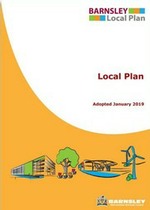

Biodiversity
Action
Plan

Planning and Development.
A key part of Barnsley Council’s planning policies is to seek to minimise and mitigate any adverse impacts on biodiversity and to enhance and provide net gains in biodiversity. This is considered in deciding whether to approve or refuse a planning application.
Some developers and land owners take pride in the contribution they can make to enhance the environment and respond positively to the need to protect and enhance biodiversity.
However Barnsley Council has regulatory and enforcement powers, sets planning conditions and agrees obligations for development.
National Policies and Legislation
The Natural Environment & Rural Communities Act 2006 sets out the statutory duty for a public authority to have regard to the purpose of conserving biodiversity in the exercise of its functions.
The Environment Act 2021 makes explicit that the duty is to conserve and enhance biodiversity. It set the requirement for new development to demonstrate a 10% Biodiversity Net Gain. This applies from November 2023 (small sites April 2024).
The National Planning Policy Framework as revised in 2021 states that planning policies and decisions should contribute to and enhance the natural and local environment, including by
- protecting and enhancing valued landscapes, sites of biodiversity or geological value and soils (in a manner commensurate with their statutory status or identified quality in the development plan)
- minimising impacts on and providing net gains for biodiversity, including by establishing coherent ecological networks that are more resilient to current and future pressures. [NPPF para 174]
It also states that plans should promote …
- conservation, restoration & enhancement of priority habitats & ecological networks
- protection & recovery of priority species;
and identify and pursue
- opportunities for securing measurable net gains for biodiversity. [NPPF para 179]
Barnsley Council’s Biodiversity policy is given in its Local Plan. A Supplementary Planning Document on biodiversity was published by Barnsley Council in 2019, updated in 2024.
Details of Barnsley’s priority & protected species, priority habitats & designated sites are given in this Biodiversity Plan.
- Local planning authorities have a statutory duty to have regard to conserving and enhancing biodiversity in the planning process.
- Local authorities have a responsibility in the planning process to promote the maintenance and long term conservation of sites, habitats and species of international, national and local importance.
- Biodiversity features of value frequently occur outside designated sites; local authorities need to ensure that these are conserved, enhanced and additional features created as part of development.
- Maintaining levels of biodiversity is not enough. Development has to enhance and provide a net gain in biodiversity, and should contribute to wildlife and habitat connectivity in the wider area.
Some development sites and their immediate settings may have minimal biodiversity interest and smaller scale development such as domestic extensions or changes of use in urban settings may not create adverse impacts on biodiversity.
However it is always important to look out for such impacts. An existing building may have bats roosting and swifts nesting; a garden may be regularly visited by hedgehogs; and a brownfield patch may support notable invertebrates.
Considering potential impacts on biodiversity as well as opportunities for its enhancement and achieving net gain, should inform selection, design, planning applications, construction and ongoing uses of sites.
Developers and the planning authority also have to take account of the legal protection of certain species.
Further information is given via the following links on conserving, enhancing and achieving a net gain in biodiversity, minimising and mitigating adverse impacts, and taking account of protected species.

Planning and Development